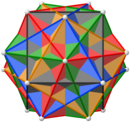Compound_of_five_cubes
Compound of five cubes
Polyhedral compound
The compound of five cubes is one of the five regular polyhedral compounds. It was first described by Edmund Hess in 1876.
| Compound of five cubes | |
|---|---|
 (Animation, 3D model) | |
| Type | Regular compound |
| Coxeter symbol | 2{5,3}[5{4,3}][1] |
| Stellation core | rhombic triacontahedron |
| Convex hull | Dodecahedron |
| Index | UC9 |
| Polyhedra | 5 cubes |
| Faces | 30 squares (visible as 360 triangles) |
| Edges | 60 |
| Vertices | 20 |
| Dual | Compound of five octahedra |
| Symmetry group | icosahedral (Ih) |
| Subgroup restricting to one constituent | pyritohedral (Th) |

It is one of five regular compounds, and dual to the compound of five octahedra. It can be seen as a faceting of a regular dodecahedron.
It is one of the stellations of the rhombic triacontahedron. It has icosahedral symmetry (Ih).



